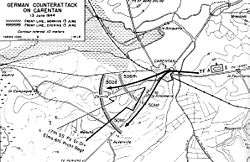Battle of Bloody Gulch
| ||||||||||||||||||||||||||||||
The Battle of Bloody Gulch took place near Hill 30 (U.S. Army designation) approximately 1 mile (1.6 km) southwest of Carentan in Normandy, France on June 13, 1944, between elements of the German 17th SS Panzergrenadier Division and 6th Fallschirmjäger Regiment, and the American 501st, 502nd and 506th, Parachute Infantry Regiments (PIR) of the U.S. 101st Airborne Division, reinforced by elements of the U.S. 2nd Armored Division.
Battle
When the 101st Airborne entered the town of Carentan on June 12, 1944 (D-Day + 6) after heavy fighting on the two previous days, they met relatively light resistance. The bulk of the surviving German defenders (from the 6th Fallschirmjäger Regiment) had withdrawn to the southwest the previous night after a heavy Allied naval and artillery bombardment. Both sides realized the importance of the town: for the Americans, it was a link between Utah Beach and Omaha Beach, and would provide a base for further attacks deeper into German-occupied France. For the Germans, recapturing Carentan would be the first step towards driving a wedge between the two U.S. landing beaches, severely disrupting and possibly even destroying the Allied invasion.
The remnants of the 6th Fallschirmjäger resupplied and were reinforced by assault guns and panzergrenadiers of the 17th SS Panzergrenadier Division on the night of June 12–13. The combined force counterattacked northeast towards Carentan at dawn on June 13, just as the 506th and 501st PIR were attacking southwest to enlarge the American defensive perimeter around the town. The 506th took the brunt of the attack, and by 10:30 a.m., the outnumbered and outgunned paratroopers were pushed almost back to the outskirts of the town.
Under intense German fire, F Company of the 506th's left flank broke and fell back. This exposed D Company's right flank, who also fell back, leaving E Company all alone. Cpt. Thomas P. Mulvey, the commanding officer of F Company,[2] was relieved on the spot by Lt. Colonel Robert Strayer. When a German StuG assault gun attempted to penetrate the left flank, Lt. Harry Welsh and Pvt. John McGrath of E Company successfully destroyed it with a bazooka. This gave time for battalion headquarters to stop the retreat of D and F companies, pushing them forward 150 meters to cover the left flank.[1] The 2nd Battalion of the 502nd PIR took up positions to the right of the 506th, but by 1:00 p.m. they too had suffered many casualties, and the German attack was on the verge of breaking through their defenses.
At this critical point, sixty tanks from Combat Command A of the 2nd Armored Division and accompanied by infantry of the 29th Division,[1] counterattacked southwest from Carentan at 4:30 p.m.,[1] inflicting severe casualties on the Germans and forcing them to withdraw. The American victory led to the linkup of forces from Utah and Omaha beaches, creating a secure lodgement area for further American operations.
The actions of the 507th Parachute Infantry Regiment during the Graignes incident (better known as the Battle of Graignes) south-west of Carentan, played a part in the successful capture of Carentan and the Battle of Bloody Gulch. Had the mis-dropped paratroopers of the 507th not stopped the advance of the 17th SS Panzergrenadier Division, it is possible that the German division could have made it to Carentan before the 101st Airborne Division. What's more, the 507th caused the Germans significant losses in the few days that they were holding Graignes and this likely influenced the battle at the Bloody Gulch.
The battle in popular culture
- Television
- Band of Brothers, an HBO series, in its third episode Carentan portrays the 506th PIR's part in the battle.
- Video games
- Brothers in Arms: Road to Hill 30 and Brothers in Arms: Earned in Blood include the Battle of Bloody Gulch
- Company of Heroes also features the defense of Carentan
- Call of Duty 2 features a multiplayer map set in Carentan
- Red Orchestra: Ostfront 41-45 modification Darkest Hour: Europe '44-'45 features a multiplayer Carentan map
- Red Orchestra 2: Heroes of Stalingrad modification Heroes of the West features a multiplayer Carentan map
References
- 1 2 3 4 Ambrose, Stephen E. (September 2001). Band of Brothers. ISBN 0-7434-2990-7.
- ↑ "History 2nd Bn.". 506infantry.org. Archived from the original on August 5, 2012.
Further reading
- ""The Battle of Carentan, 8–15 June"". Utah Beach to Cherbourg. United States Army Center of Military History. 1990. CMH Pub 100-12.
- Donald Burgett (2000). Currahee!: A Screaming Eagle at Normandy. Dell Publishing. ISBN 0-440-23630-4.
